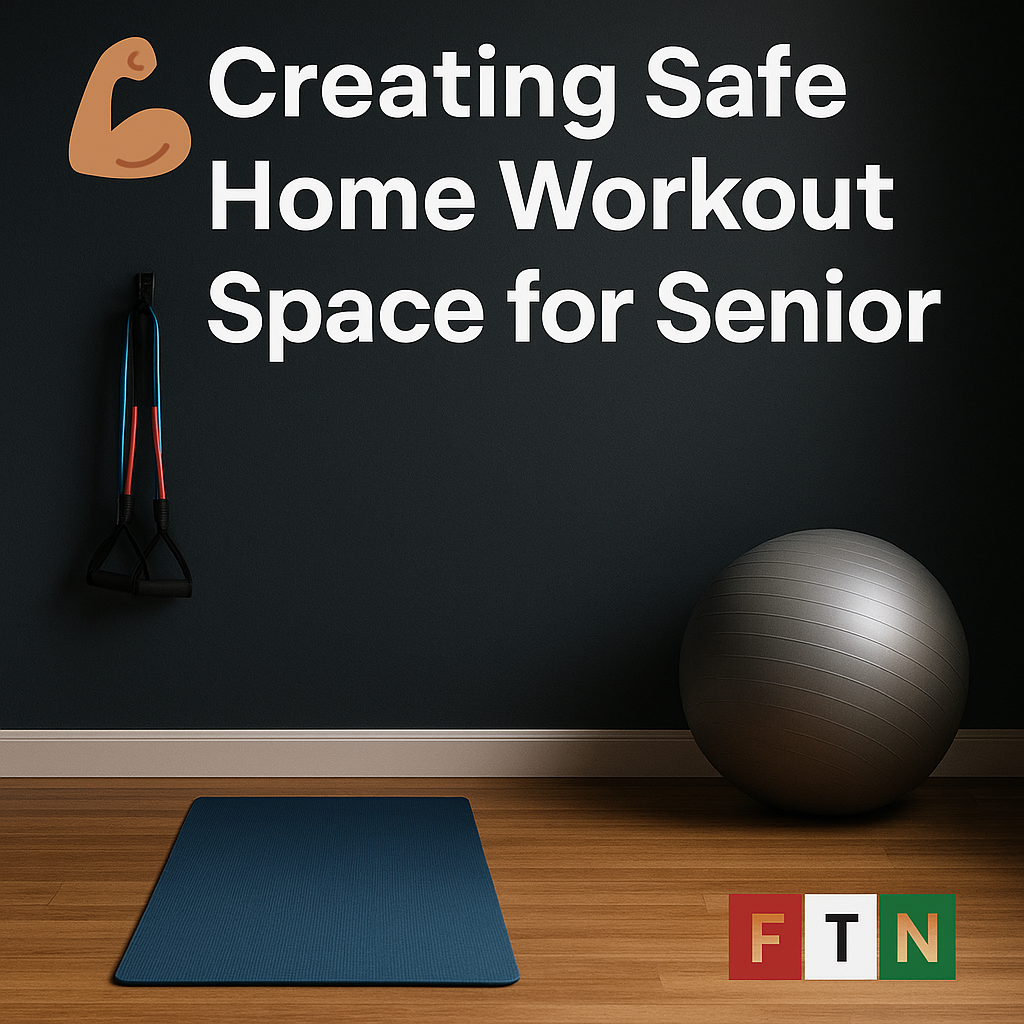Understanding the Importance of a Safe Workout Space for Seniors 👴🏻🏡💪
As we age, staying physically active becomes more important than ever. For seniors, regular exercise supports mobility, balance, strength, and heart health. But just as crucial as the exercise itself is where it’s done. A safe and well-prepared workout space can make the difference between successful aging and preventable injury.
Creating a safe workout environment at home allows seniors to exercise confidently and consistently. From reducing fall risks to encouraging independence, a safe space is the foundation for a healthier, more active lifestyle.
Why Safety Matters for Senior Workouts 🛑🚶♂️
For older adults, the benefits of exercise are immense. Physical activity helps manage weight, reduces the risk of chronic illnesses like heart disease and diabetes, strengthens bones and muscles, and boosts mental health. However, seniors are also more vulnerable to injuries, particularly from falls or joint strain.
A cluttered, poorly lit, or uneven workout space can turn a healthy habit into a dangerous one. By designing an environment that puts safety first, seniors can focus on moving their bodies without fear of injury. A clean, supportive space also builds confidence, making it more likely they’ll stick to their fitness routine.
Step 1: Assessing the Workout Area at Home 🏠📏
Start by identifying a suitable space in the home. It doesn’t need to be large—a quiet corner in the living room or bedroom can work well. The key is space and accessibility.
Ask yourself:
Is there enough room to move freely without bumping into furniture
Are floors flat and non-slippery?
Is the space easy to enter and exit, especially with mobility aids
Remove loose rugs, electrical cords, or anything that could be tripped over. Brighten the area with natural or artificial lighting, and avoid shadows that could hide obstacles.
Step 2: Choosing Senior-Friendly Exercise Equipment 🧘♂️🧰
Seniors should avoid bulky or complicated gym machines. Instead, opt for simple, safe, and effective tools, such as:
Resistance bands: Gentle on joints, adjustable in tension, and perfect for strength training without heavy lifting.
Light dumbbells: Preferably 1–5 pounds with non-slip grips for safety and comfort.
Yoga or exercise mats: Choose a non-slip mat that provides cushioning and stability for stretching or floor exercises.
Sturdy chairs with arms: Ideal for seated exercises, balance support, or transitions from sitting to standing.
Avoid unstable or overly complex machines. Focus on ease of use and adaptability to personal needs.
Step 3: Designing a Senior-Safe Layout 🧩🚫
Once the space and equipment are selected, the layout becomes key. Seniors need plenty of room to move without bumping into furniture or feeling confined.
Safety layout tips:
Keep at least 3 feet between equipment or furniture.
Store all gear in accessible bins or shelves to avoid clutter.
Use rubber flooring or low-pile carpet to prevent slipping.
Install anti-fatigue mats in standing workout areas for joint support.
If the room transitions between different floor types (e.g., hardwood to tile), use transition strips to smooth out edges and reduce trip risks.
Step 4: Adding Extra Safety Features 🛠️🧯
Incorporate small but powerful additions to maximize safety:
Grab bars: Install near workout chairs or walls for extra balance support.
Proper lighting: Bright, even lighting prevents missteps. Consider motion-sensor lights for added convenience.
Emergency response: Seniors should keep a cell phone or medical alert device within reach during workouts in case help is needed quickly.
Stable furniture: Avoid using rolling chairs or flimsy objects for balance.
If possible, have a family member or caregiver nearby during workouts—especially in the beginning stages.
Step 5: Building a Safe and Effective Routine 📅✅
A workout plan for seniors should be low-impact, gradual, and consistent. Jumping into intense exercise is not only discouraging but also dangerous.
Best practices for a senior-safe workout plan:
Begin with 10–15 minute sessions, then gradually increase time and intensity.
Focus on low-impact exercises: walking, stretching, light strength training, and balance exercises.
Incorporate rest days to allow the body time to recover.
Monitor for signs of overexertion: dizziness, joint pain, or unusual fatigue.
It’s wise to consult a doctor or physical therapist before beginning a new fitness regimen, especially if there are preexisting health conditions.
Step 6: Using Online Tools and Classes for Seniors 📲🎥
Technology offers an amazing range of online fitness content designed especially for older adults. These virtual classes are accessible, fun, and often free.
Here are a few senior-friendly platforms:
SilverSneakers: Offers full-length video workouts tailored to seniors.
YouTube Channels like Senior Fitness with Meredith or The Body Coach TV have hundreds of guided routines.
Fitness apps like MyFitnessPal or Keep Moving allow for goal setting and activity tracking.
Live or recorded classes offer flexibility, structure, and a sense of routine—important factors for long-term fitness success.
Step 7: Promoting Social Interaction Through Exercise 👭🗣️
Exercise is not just physical—it’s social. Seniors who work out with others tend to stay motivated longer and experience less loneliness.
Ways to promote social fitness:
Join online group classes with live interaction.
Start a neighborhood walking club.
Invite friends or family members to join virtual or in-person workouts.
Plan weekly fitness “dates,” even if it’s a light stretch together.
Group settings make exercise feel less like a chore and more like a social event to look forward to.
Step 8: Tracking Progress and Staying Flexible 📈📝
Tracking fitness progress helps seniors stay motivated and recognize their improvement over time. Keep a simple fitness journal to log:
Workout type and duration
How they felt before and after
Any soreness or discomfort
Milestones like balance improvement or increased strength
Be ready to adjust the routine as needed. If an exercise becomes too easy, add a small challenge. If it causes discomfort, swap it out. Flexibility ensures safety and keeps workouts enjoyable.
Final Thoughts: A Safer Space, A Stronger Life 🧡🌟
A safe workout space isn’t a luxury—it’s a necessity for seniors. It’s the key to unlocking physical health, emotional wellness, and lasting independence.
With thoughtful planning, the right equipment, and a dose of encouragement, seniors can embrace fitness with confidence. Whether it’s a morning stretch, a seated strength session, or a gentle walk, each movement matters. Safety doesn’t limit activity—it enables it.
Let’s create spaces that empower our loved ones to age actively, safely, and joyfully.
🎥 Video Review:
“30 Minute Full Body Home Workout for Seniors” – ElderFit TV
Watch here
✅ What Works Well (Strengths):
- Clear Senior Focus
The exercises are gentle, low-impact, and designed with aging bodies in mind. Perfect for viewers 60+ with limited mobility. - Calm & Friendly Instruction
The instructor speaks slowly, clearly, and maintains a calm tone — great for seniors who may be intimidated by fast-paced fitness videos. - Chair-Based Options Included
Standing and seated variations make this routine accessible to almost everyone, including those with balance or joint issues. - Simple Environment
The space shown is clutter-free and well-lit, matching your article’s advice about creating a safe workout area. - Full-Body Approach
It includes balance, coordination, stretching, and light strength — which aligns with what your readers are looking for.
🔧 Suggestions for Improvement:
If you’re recommending this video to your audience or contacting the creator for future collaboration, here are key areas they could enhance:
- Add On-Screen Movement Labels
Suggestion: Display text like “Shoulder Rolls – 1 Minute” or “Seated Marches” as each exercise begins.
Why? Helps seniors follow along more easily and reduces confusion if they miss the verbal cue.
- Include a Visible Timer or Progress Bar
Suggestion: A corner countdown timer or segment progress bar.
Why? Gives seniors a sense of structure and reassurance about how long they’ll be moving. It also encourages them to stay committed.
- Improve Audio Clarity Slightly
The instructor’s voice is calm, but slightly echoey. Using a lapel mic or clearer audio setup would improve comfort and comprehension for older viewers (many of whom may have hearing difficulties).
- Add Warm-Up and Cool-Down Labels
Suggestion: Clearly label sections like:
“Warm-Up (5 mins)”
“Main Exercises”
“Cool-Down / Stretch”
Why? It mentally prepares the viewer and adds structure. Seniors benefit from knowing what phase they’re in.
- Include Optional Modifications for Mobility Tools
Suggestion: Briefly mention how someone using a walker or cane can modify certain moves.
Why? Increases accessibility for seniors with physical limitations and builds confidence.
- Add Captions/Subtitles
Auto-generated captions can be inaccurate. Manually added captions would greatly help:
Seniors with hearing issues
Non-native English speakers
Mobile viewers watching with the sound off
- Thumbnail Improvement
The current thumbnail is minimal.
Suggestion: Use a brighter, more inviting thumbnail with:
A senior smiling in workout gear
Text overlay like: “Easy Full-Body Workout for Seniors | No Equipment Needed”
Why? Thumbnails matter for click-through, especially on mobile. Make it friendly, clear, and visually appealing.
🧠 Final Evaluation:
Category Score (out of 10)
Senior-Friendly 9.5
Instruction 8.5
Visual Clarity 8.0
Accessibility 7.5
Audio Quality 7.5
Overall Impact 8.5

